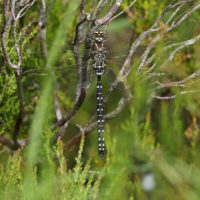In this case, my friends in question were one of our dragonfly recorders, let’s call him Pablo, and his partner, Susana. They had coincidentally arranged a short break to travel to Gairloch, to coincide with ours, also in search of my 2nd target species, the Azure Hawker (Aeshna caerulea). So, we’d both done some research and would be able to pool resources. Eight eyes are better than four. Yesterday, after picking up some irresistible venison pastrami and squat lobster tails from Poolewe’s Tuesday market, Francine and I had been heading back into Poolewe on foot when a toot behind made us jump. Pablo and Susana had arrived and had found us whilst they had been driving through. We shared a coffee at the Spanish run Bridge Cottage Cafe followed by la late-ish lunch chez Guillaume.
We were surprised to learn that Pablo had been given an additional suggestion by the tourist information office steering him to a likely hunting ground a few miles north of Poolewe at Laide Wood. How great to see that the local tourist information apparently included information about their celebrity dragonflies. Wonderful!. We set off in convoy under the familiar grey skies to check it out.
 Laide Wood provided a parking area complete with a map. There was a circular route with two ponds marked at the far side. Promising, if the weather would only brighten up. We set off and soon logged the ubiquitous Large Red Damselfly (Pyrrhosoma nymphula) and Common Bluetails (Ischnura elegans). Things got a little more exciting when we spotted a female so-called Highland Darter. Unfortunately [in my eyes, that is], rather than being a distinct species, the erstwhile Highland Darter (Sympetrum nigrescens) [as was] has been shown by DNA tests to be just a darker form of the Common Darter (Sympetrum striolatium). It does look noticeably different, though, so perhaps referring to it as Sympetrum striolatum form nigrescens might be reasonable.
Laide Wood provided a parking area complete with a map. There was a circular route with two ponds marked at the far side. Promising, if the weather would only brighten up. We set off and soon logged the ubiquitous Large Red Damselfly (Pyrrhosoma nymphula) and Common Bluetails (Ischnura elegans). Things got a little more exciting when we spotted a female so-called Highland Darter. Unfortunately [in my eyes, that is], rather than being a distinct species, the erstwhile Highland Darter (Sympetrum nigrescens) [as was] has been shown by DNA tests to be just a darker form of the Common Darter (Sympetrum striolatium). It does look noticeably different, though, so perhaps referring to it as Sympetrum striolatum form nigrescens might be reasonable.
 The first pond produced nothing so we went to the second, which had better access. Now approaching 16:30, a few breaks in the cloud looked as if they may get to us. We waited and amused ourselves with another teneral Highland Darter and some Bluetails. A relaxing Common Goldenring (Cordulegaster boltonii) was also spotted and gave us more entertainment. These are commonplace for Pablo, living near them, but a thrill for someone from Bedfordshire, where they do not fly.
The first pond produced nothing so we went to the second, which had better access. Now approaching 16:30, a few breaks in the cloud looked as if they may get to us. We waited and amused ourselves with another teneral Highland Darter and some Bluetails. A relaxing Common Goldenring (Cordulegaster boltonii) was also spotted and gave us more entertainment. These are commonplace for Pablo, living near them, but a thrill for someone from Bedfordshire, where they do not fly.
 Then we spotted something hawking along a tree line at our end of the pond. In flight, brief glimpses made it look as if it might be our target. Four pairs of eyes all watched eagerly. It was very active, flying fast and changing direction rapidly and unpredictably. It didn’t show any signs of settling. Then it It disappeared along with the sun as our window through the clouds closed. After some time another window opened, the sun returned and along with it our suspected Azure Hawker. It zoomed about haphazardly as before but eventually, this time, settled on some heather, just once and quite briefly. Its colouring was good camouflage against the heather. but Francine was nearest, spotted where it landed and managed a grab shot.
Then we spotted something hawking along a tree line at our end of the pond. In flight, brief glimpses made it look as if it might be our target. Four pairs of eyes all watched eagerly. It was very active, flying fast and changing direction rapidly and unpredictably. It didn’t show any signs of settling. Then it It disappeared along with the sun as our window through the clouds closed. After some time another window opened, the sun returned and along with it our suspected Azure Hawker. It zoomed about haphazardly as before but eventually, this time, settled on some heather, just once and quite briefly. Its colouring was good camouflage against the heather. but Francine was nearest, spotted where it landed and managed a grab shot.
Guess what. Our friend was a male Common Hawker (Aeshna juncea) and not our highly prized Azure Hawker (Aeshna caerulea). Now, I have only ever had two previous encounters with Common Hawkers so this was not unwelcome; it just wasn’t what we’d all been hoping for. 🙂

When I first posted this whilst on the road in Scotland, I was still under the mistaken impression that the final dragonfly was our intended quarry, an Azure Hawker (Aeshna caerulea). I realized my mistake – it is, in fact, a Common Hawker (Aeshna juncea) – as I was subsequently submitting records.
How embarrassing. I have now corrected the text above accordingly.